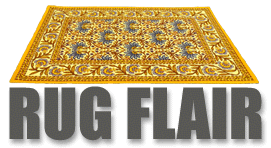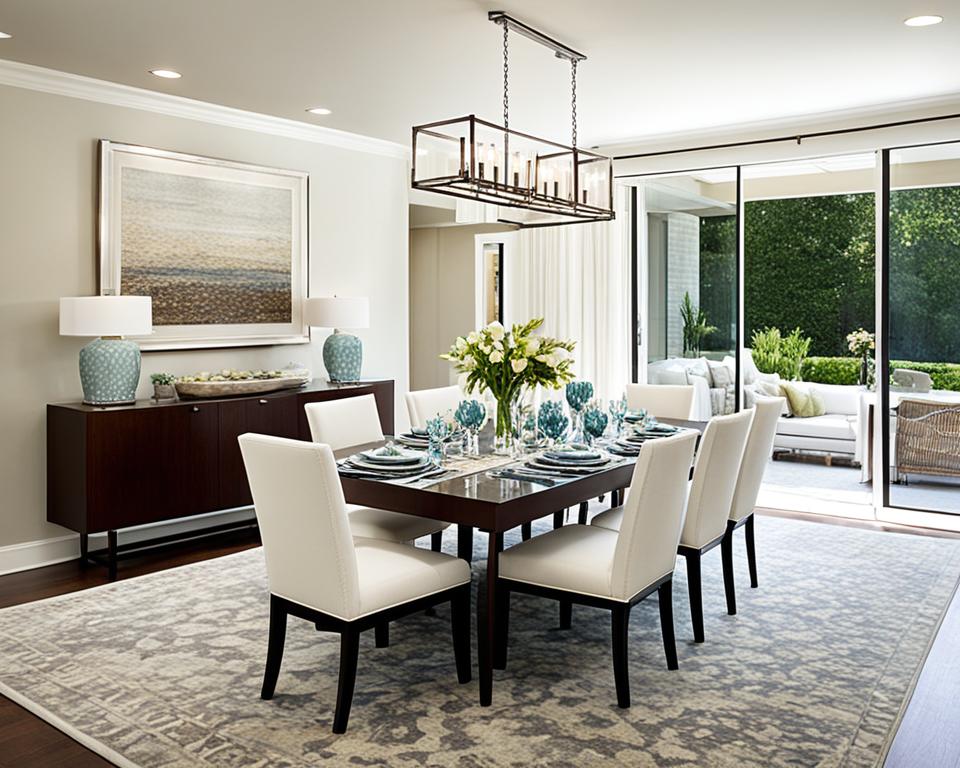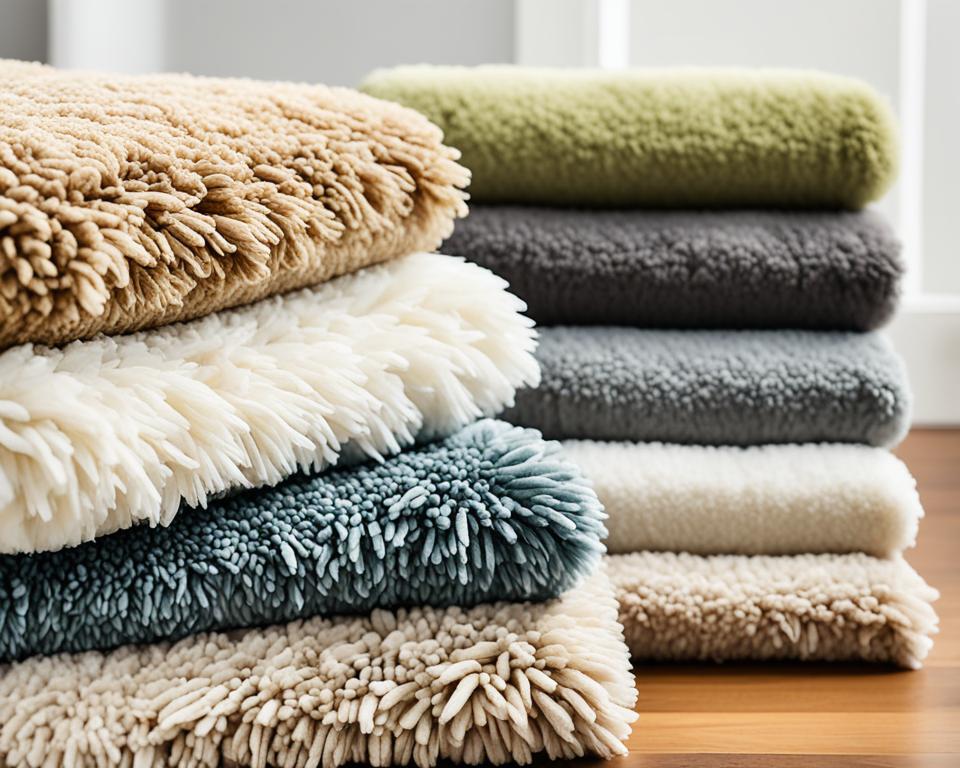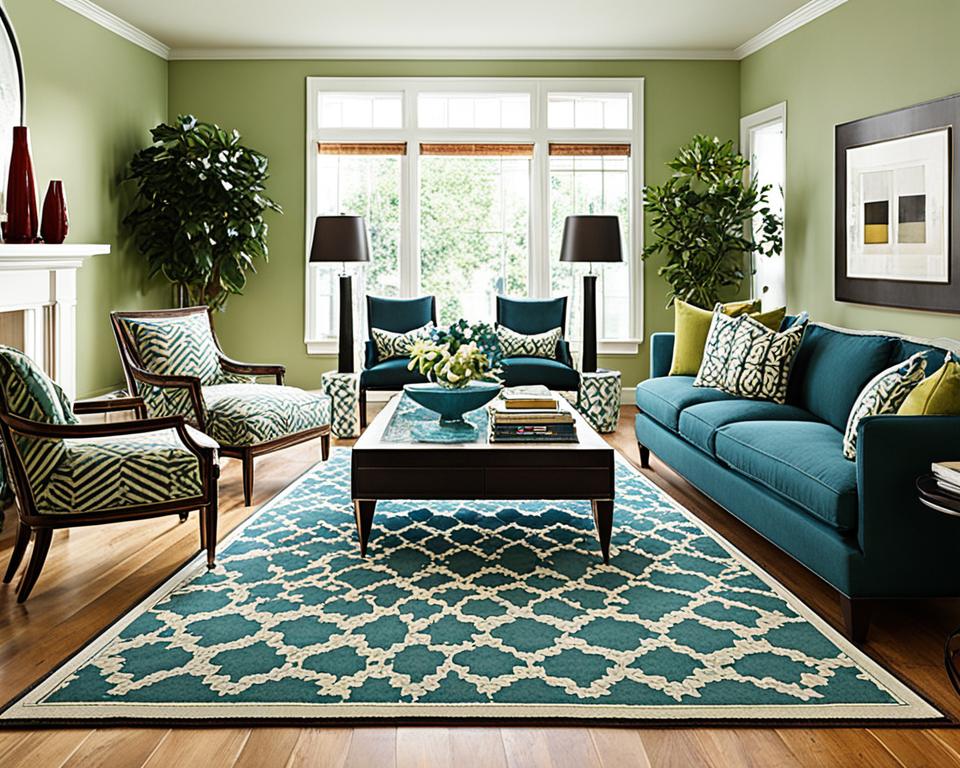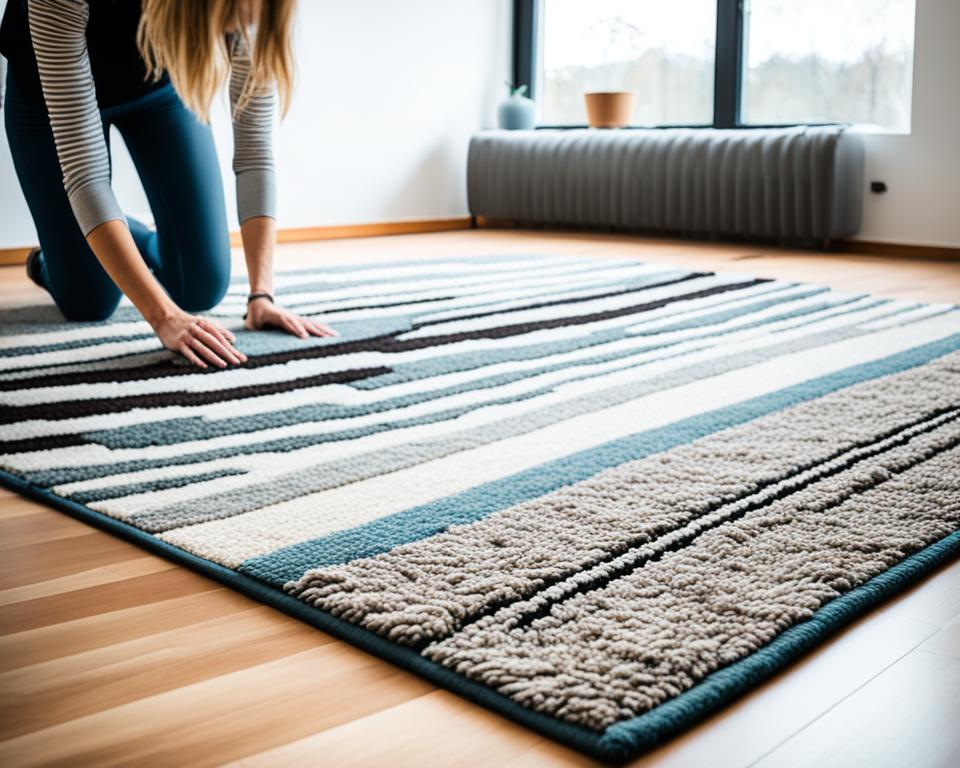Have you ever walked into a room and your gaze was immediately drawn to the luxurious rug underfoot, wondering why are rugs so expensive? It’s not just your eyes that perceive the value; there’s an entire tapestry of factors that contribute to the luxury rug pricing. From oh-so-plush Moroccan pieces to intricately designed Persian heirlooms, each rug carries with it a lineage of masterful craftsmanship and a whisper of historical narrative.
Understanding rug pricing goes beyond admiring the aesthetic beauty—it’s a dive into a world where tradition meets meticulous artistry. These handwoven marvels are emblematic of cultural reverence and are created not in a rush of production but with a deliberate and patient dedication to excellence.
You might wonder if their high cost matches their value. Rest assured, the price tag of these woven treasures encompasses the ethical considerations of fair trade and the artisans’ welfare, the use of pristine-quality materials, and the preservation of time-honored techniques. Read on as we unravel the threads that weave together to form the high price of these coveted home accents.
Key Takeaways
- High-end rugs come with prices reflective of their quality, cultural significance, and ethical production.
- The handcrafted nature and intricate designs of Moroccan and Persian rugs contribute to their luxury status.
- Understanding the high cost of rugs includes appreciating the exceptional materials, such as fine wool and natural dyes.
- Artisan skill, steeped in generations of tradition, bolsters both the aesthetic appeal and the price of these rugs.
- Commitment to sustainability and fair labor practices adds intrinsic value to the true cost of ethically produced rugs.
- The rarity and limited supply of hand-knotted rugs serve to elevate their market value.
The Intricacies of Rug Craftsmanship
When you consider acquiring a luxurious rug, you might pause at the price tag and ponder why these decorative pieces command such high value. Expensive rugs explained within the context of their creation reveal a world of intricate manual labor and artisanship that is seldom matched in other commodities. The cost breakdown of these handwoven rugs unveils the profound expertise and time required to bring such magnificent pieces to your living space.
Before the first thread is spun, the journey of crafting a handwoven rug begins with a vision and a tradition-imbued design. Let’s delve deeper into the meticulous process and the factors that contribute to the coveted nature and high price of these artisanal creations.
Time-Intensive Weaving Processes
The creation of a single handwoven rug is a narrative in itself, unfolding across weeks or even months. With each pass of the weaver’s hand, the rug slowly comes to life, reflecting the commitment that quality craftsmanship demands. The lengthy duration of weaving is intrinsic to why these rugs are often expensive, for each is not an off-the-shelf product but a personalized work of art.
Artisan Skill and Tradition
The mastery of rug craftsmanship lies in the hands of artisans who have inherited their skills from generations before them. From the Berber tribes of Morocco to the skilled weavers of Iran, these artisans imbue each rug with a piece of cultural identity, articulated through every knot and weave. This continued tradition furnishes a link to the past, elevating the rug from a mere household item to a storied heirloom.
The Influence of Hand-Spun and Dyed Materials
Let’s not forget the raw materials—wool often hand-spun in anticipation of dying it with a spectrum of natural colorants derived from the earth’s offerings. This time-honored tradition of dyeing and spinning by hand enriches the rugs with authenticity and a distinctness that is palpable not just in their appearance but also to the touch.
To offer clarity on rug cost breakdown, the following table compares the crucial steps in handwoven rug creation and their impact on pricing.
| Creation Step | Details | Impact on Cost |
|---|---|---|
| Design and Planning | Cultural and symbolic motifs selected | Increase due to cultural significance |
| Material Preparation | Hand-spinning of wool and natural dying | Increase due to manual labor and material quality |
| Weaving Process | Knot by knot execution of design | Significant increase due to time investment |
In sum, the rug you choose to adorn your home is a testament to an age-old skill—a worthy treasure crafted with a depth of history and culture. As the essence of rug craftsmanship beautifies your space, it continues to uphold the legacies of artisans who dedicated their lives to honing this art form.
Materials Matter in Luxury Rug Pricing
Exploring the factors that determine rug price factors, one cannot overlook the crucial role of the materials used. The selection of fabrics and the process by which they are integrated into the final design are pivotal in setting the pricing benchmarks for luxury rugs. Specifically, the durability and texture of fine wool combined with the use of natural dyes contribute significantly to both the cost and the splendor of these pieces.
The Durability and Texture of Fine Wool
Wool rugs represent a quintessential blend of longevity and luxurious feel. Specially sourced fine wool from sheep in the Moroccan highlands for example, is a preferred choice for high-end rugs. Known for its exceptional rug durability and inviting texture, this material is a linchpin in the longevity of a rug, ensuring that it remains a part of your home’s décor for years to come. These characteristics of wool rugs not only improve the aesthetics but also serve as a testament to the phrase ‘you get what you pay for’ when it comes to the rug price factors.
Natural Dyes vs. Synthetic: Why It Affects the Price
Contrary to the more commonly used synthetic dyes, rugs with natural dyes command a higher place in the luxury marketplace. This is due to the time-intensive method of extracting colors from plants and insects—a process that has been honed over centuries. This use of natural rug materials not only aligns with an eco-friendly ethos but also provides a unique color palette that matures gracefully over time, adding to the rug’s visual charm with a rich patina that can’t be found in synthetic counterparts. The careful procedure of dyeing contributes to the overall cost but results in an irreplaceable masterpiece gracing the floors of discerning homeowners.
The information below provides insight into the connection between material choice and cost, which should be at the forefront when considering a luxury rug purchase:
| Material Aspect | Relevance to Pricing | Impact on Final Product |
|---|---|---|
| Fine wool sourcing | Fine wool, especially from exotic locations, often has limited availability and higher costs associated with ethical farming practices. | Enhanced durability and superior texture, leading to prolonged rug life and richness underfoot. |
| Use of natural dyes | Costly due to labor-intensive extraction processes but preferred for their environmental friendliness and unique aging characteristics. | Ages gracefully with a distinctive patina, increasing aesthetic appeal over time. |
| Environmental considerations | Financial investment in sustainable and ethical material procurement adds to overhead costs. | Eco-friendly rugs align with modern conservation values, ensuring a product that stands for more than just luxury. |
In your quest for the perfect rug, remember that the upfront investment reflects not just a path to enhancing your living space, but also a choice that resonates with quality, sustainability, and timeless appeal. The convergence of rug durability, use of natural rug materials, and the artistry behind the weaving of wool rugs work synergistically to justify the premium pricing of these handcrafted marvels.
Cultural and Artistic Significance in Every Thread
As you explore the world of rugs, you’ll quickly find that each piece holds a reflection of the world from which it originates, intricately interwoven with the cultural significance of rugs. The artistry captured in the fibers of each rug narrates a story that transcends time and geography, making these pieces not just additions to your home, but ambassadors of a rich tapestry of history.
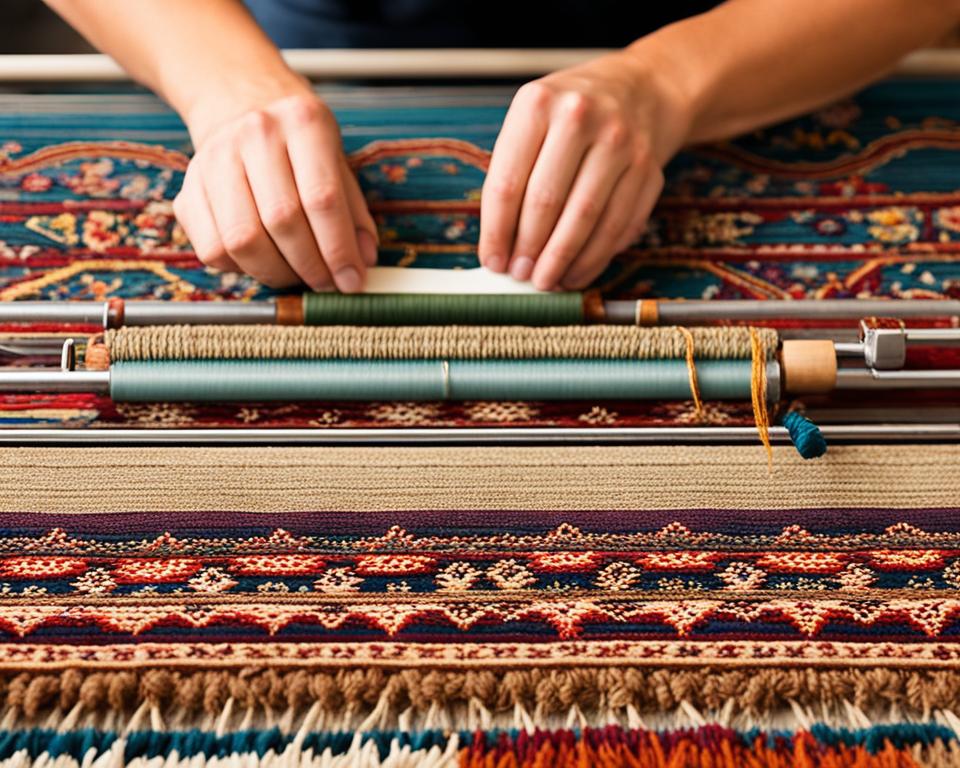
Weaving Stories: The Role of Cultural Heritage
The wefts and warps of Moroccan rugs are not just threads; they are strands of time, each possessing the essence of Morocco’s cultural heritage. The Berber weavers of Morocco intricately craft patterns that hold centuries of tradition, each rug a chronicle of the past. The cultural heritage in rugs like these provide a physical representation of a country’s history, acting as a bridge between modern decor and ancestral narratives.
Rugs as a Form of Artistic Expression
Exceptionally, rugs have the ability to function as tangible expressions of art. Far beyond their utilitarian purpose, artistic rugs are conceived out of personal stories and societal beliefs. In every knot and pattern, weavers from diverse cultures—such as the Berber tribes—imbue their own identities, sharing their perspectives with the world. It’s these personal inflections that elevate rugs beyond mere objects to be tread upon; they become living canvases of artistic tradition.
Whether it’s the vibrant, telltale hues of Persian rugs or the symbolic motifs found in the tapestry of Moroccan lore, each rug is a masterpiece in its own right. They do not just add beauty to a room; they resonate with the voices of artisans whose expertise is steeped in tradition. Through these creations, admirers of cultural and artistic significance can actually touch, see, and feel the legacies that have been meticulously crafted into existence, one thread at a time.
Why Are Rugs So Expensive? Demand Meets Limited Supply
If you’ve ever participated in a high cost of rugs reddit discussion, you know that many factors contribute to the pricing of luxury home décor. Among these, the rug supply and demand dynamic plays a pivotal role. The production of rugs, especially handcrafted ones from regions like Morocco and Persia, cannot be ramped up to meet spikes in demand due to the meticulous, time-consuming process required to create each piece. The result is a marketplace where limited edition rugs carry a rarity that is both a hallmark of exclusivity and a contributor to the higher costs.
The allure of uniqueness in each handmade rug means that collectors and enthusiasts are often willing to pay a premium for designs that aren’t found in every store or home. Just as a limited-edition art print or a rare vintage wine can command top dollar, so too can a rug that is one of a kind. This section explores how the scarcity and artisanal nature of such rugs affect their market value.
| Aspect | Impact on Supply | Effect on Market Value |
|---|---|---|
| Handmade Craftsmanship | Limited by the time and skill required for production | Increases due to the uniqueness and artisanal quality |
| Exclusivity of Design | Only a finite number of pieces can be produced with a specific design | Drives up demand, as collectors seek unique pieces |
| Availability of Materials | Quality materials may have limited availability | Further limits supply, adding to exclusivity |
As you consider adding a luxurious rug to your space, remember that the price is a reflection of more than just the material from which it’s made. It’s also a measure of the culture, artistry, and exclusivity embedded within its very fibers. When rug supply and demand constrict availability, you’re not just acquiring a rug; you’re investing in a piece of art that holds its value well into the future, resonating with the legacy and craftsmanship of its creators.
Sustainability and Ethical Manufacturing: The Hidden Costs
When exploring the topic of sustainable rug making, it’s vital to understand that behind every ethical product is a story of commitment and value. In the context of ethical manufacturing of rugs, this commitment often translates into higher production costs that reflect the artisans’ well-being and the protection of our planet. As a consumer, your choice to invest in such items directly supports these principles, albeit at a premium. But why exactly does sustainability carry a higher price tag?
The true cost of sustainable rug making extends beyond raw materials and labor. It envelops the aspirations for greener production practices and the safeguarding of artisans’ rights. This section presents a rich tapestry of reasons that account for the higher cost of rugs produced under ethical conditions.
Conscious consumerism has sparked a costly rugs discussion, one where the value of a rug is not only measured in currency but in the impact its creation has on environmental and social systems. Let’s break down what comprises the higher costs of sustainable and ethically manufactured rugs:
| Aspect of Rug Manufacturing | Details and Benefits | Addition to Cost |
|---|---|---|
| Fair Labor Conditions | Ensuring artisans receive fair wages and work in safe environments. | Higher labor costs to provide a living wage and maintain safety standards. |
| Eco-Friendly Materials | Sourcing sustainable materials like organic wool or recycled fibers. | Costs more than conventional materials due to lower economies of scale. |
| Environmentally Responsible Production | Adopting practices that reduce carbon footprint and environmental impact. | Investment in greener technologies can increase operational costs. |
In acknowledging the nuances of sustainable rug making, it becomes clear that these commodities are more than just items of luxury; they’re embodiments of a movement towards a more conscientious world. By choosing rugs crafted with ethical considerations in mind, you’re not simply decorating your home—you’re supporting a legacy of responsibility and respect for those who make your treasured pieces.
So, next time you encounter a costly rugs discussion, remember that each sustainable rug you procure contributes to a greater good. It’s an investment not only in the beauty and culture imbued within its fibers but also in an ethical ideology that redefines luxury in terms of planetary and humanistic care.
From the Loom to Your Living Room: Understanding Rug Pricing
If you’re considering buying expensive rugs, it helps to understand the myriad elements that compose their pricing. The journey of a rug from creation to finding a cherished place in your home is rich with artistic endeavor and business acumen. Specifically noteworthy is the direct artisan trade, a pivotal aspect in the commerce of high-end rugs that ensures a fair deal for the creators and an exceptional product for the customer.
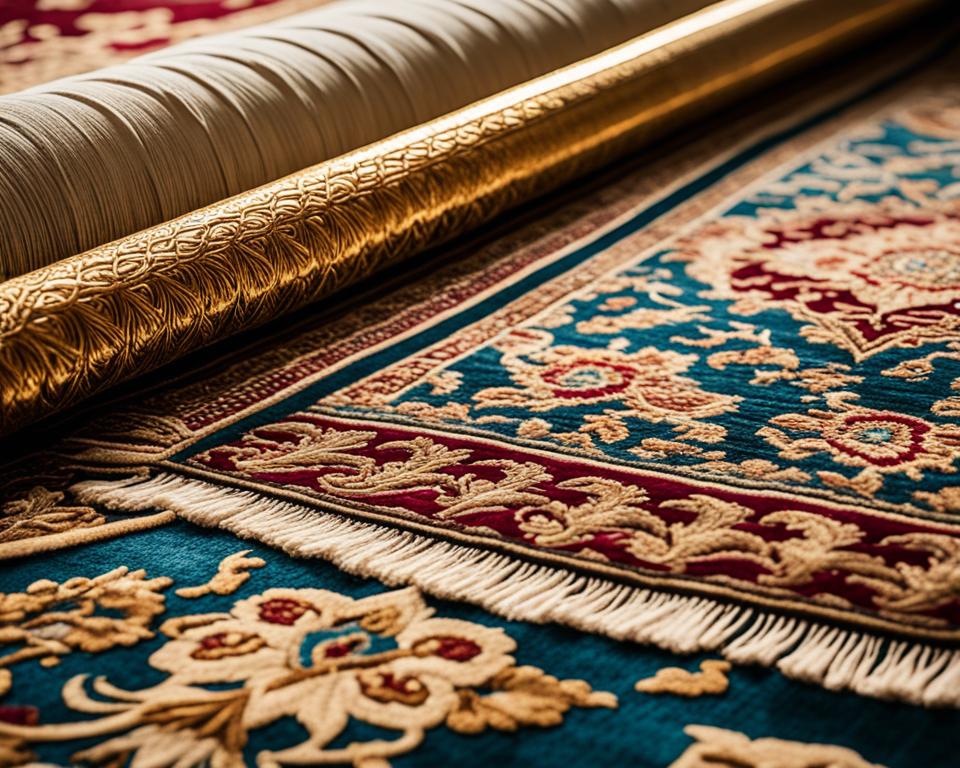
Direct Trade with Artisans
The philosophy behind direct artisan trade is refreshingly straightforward – by bypassing intermediaries, artisans receive proper remuneration for their meticulous efforts. When you invest in a rug sourced this way, you’re not just procuring an item of decor; you’re contributing to a sustainable economic cycle that values craftsmanship. This ethical sourcing model often threads into the factor of luxury rug pricing, bolstering the ethos that quality comes with the respect deserved by the artisan’s toil.
Pricing Structures in the Rug Market
Luxury rug pricing is influenced by numerous variables, ranging from the intricacies of craftsmanship to the caliber of materials used. The pricing structures in the rug market reflect the rich cultural significance knotted into every weave. To shed light on the various components that build up the final retail price, consider the following table that breaks down the essentials:
| Element | Role in Craftsmanship | Influence on Pricing |
|---|---|---|
| Artisan Labor | Hours of meticulous hand-weaving | Direct impact from wages ensuring a fair living standard |
| Material Quality | Fine materials like wool and silk | Higher cost of premium, often imported, materials |
| Cultural Design | Patterns enriched with heritage | Value added for unique and culturally significant motifs |
| Manufacturing Process | Mostly hand-made, low-volume production | Exclusivity adds to price due to limited availability |
| Supply Chain | Minimal intermediaries in direct trade | Prices reflect the closer link between artisan and buyer |
Grasping the intricacies of these facets gives you, the buyer, an enriched understanding of what goes into luxury rug pricing. It’s not solely about the splendid final product that adorns your living space but also about the dedication to preserving art, culture, and fair commerce in the world of rugs. The endowment which each rug enriches your home with is a melange of artistry, ethical trade, and the sustenance of traditional craftsmanship, manifesting as a worthwhile investment in every fiber.
The Role of Age and Rarity in Rug Valuation
Imagine stepping into a room where an antique rug serves as the centerpiece. Imagine the stories it could tell, the feet it has felt, and the years it has weathered. Such is the allure of an aged rug that its value encompasses much more than simple aesthetics—it’s a testament to a deep historical narrative and craftsmanship that can’t be replicated. Rug enthusiasts often seek out these pieces not just for their beauty, but for their antique rug value, which can appreciate significantly over time. Let’s explore how the elements of age and rarity contribute to the appreciation and valuation of these timeless wonders.
The Graceful Aging of Antique Rugs
Appreciation of antique rugs stems from their ability to stand the test of time—growing only more cherished as they age. The ‘abrash,’ or the natural change in color over time, gives each piece a unique character, a patina that cannot be mimicked by modern reproductions. This aging process garners great admiration and consequently adds to the antique rug value. It’s a remarkable process that enhances the rug’s narrative, telling tales of its past environments and caretakers. Smoothed by countless steps and softened hues, these rugs become irreplaceable relics, prized for their aged rugs appreciation.
Scarcity and Uniqueness as Value Boosters
Now, pair the aspect of time with the notion of rarity and you get a combination that sends the rug’s worth soaring. The rarity in rugs—be it from discontinuation of a pattern, a unique dye lot, or limited production from a particular region—intrinsically boosts their valuation. Collectors and aficionados often go to great lengths to acquire rugs that embody a singular story, a snapshot of cultural heritage. Rugs like these are not mere ornaments; they are commodities of cultural pride, invariably linked to their places and people of origin and thus establishing themselves as significant financial and emotional investments.
| Antique Feature | Description | Impact on Value |
|---|---|---|
| Abrash (Aging Patina) | Color variances developed over time, enhancing the rug’s visual appeal | Increases value as it adds uniqueness to the rug |
| Historical Provenance | The documented origin or story associated with the rug | Heightens value due to historical significance |
| Rarity of Design or Origin | Uncommon patterns or weaving techniques | Augments value, making the rug a sought-after collector’s item |
Appreciating the Uniqueness of Hand-Knotted Rugs
As you stroll through the array of decorative pieces, the hand-knotted rug value stands out significantly, and for good reason. The beauty and allure of these luxury handwoven rugs lie not just in their visual appeal but in the exceptional qualities that define their rug uniqueness. Each is a testament to the intricate artistry that transforms mere threads into a rich tapestry of design and history.
The commitment to excellence starts with selecting the finest raw materials, such as silky wools and vibrant dyes, followed by the traditional techniques of spinning and dyeing each fiber by hand. It’s this painstaking attention to detail that imbues each rug with a distinctive character, one that cannot be replicated by machine. The result is a luxurious item that resonates with the spirit of its creator and the culture from which it hails.
Every knot is tied with precision, a reflection of the weaver’s skilled hands and patient workmanship. This is a slow art, and rightly so. The slow creation process ensures durability, making the rug not only a centerpiece for your home but a potential heirloom to be cherished for generations. Thus, when you select a hand-knotted rug, you’re not just purchasing a floor covering; you’re investing in a piece of art that carries the essence of a culture and the artisanship of a craft preserved through time.
The distinctiveness of each rug is evident not only in its design but also in its individual story. No two hand-knotted rugs are the same; each one is a unique creation with its nuances and subtleties. With such rug uniqueness, owners can take pride in knowing that their piece is singular in its beauty and history.
| Attribute of Hand-Knotted Rugs | Description | Contribution to Uniqueness |
|---|---|---|
| Hand-Spun Fibers | Fibers are spun by hand, adding to the texture and authenticity of each rug. | Provides a unique tactile experience and depth of character. |
| Hand-Dyed Hues | Dyes derived from natural sources give each rug a vibrant, one-of-a-kind color palette. | Ensures a rich and natural color variation that ages beautifully. |
| Intricate Knotting | Every knot is tied by hand, following traditional methods. | Creates complex patterns that machines are incapable of reproducing. |
To truly appreciate a hand-knotted rug is to understand the deep cultural footprint and the artisanal skill it encapsulates. It’s to acknowledge the long hours, the careful consideration of materials, and the creative expression that goes into every completed work. Remember, when you step onto a luxury handwoven rug, you are stepping onto a canvas of history and a fabric of stories that will continue to unfold for years to come.
The Impact of Materials on Rug Cost Breakdown
When delving into the elements that form the backbone of a rug’s pricing, the materials chosen stand at the forefront. The inherent qualities of wool and Silk mark their respective terrains in the realm of rugs, heavily influencing the tactile experience, durability, and thus the rug material costs. Keen connoisseurs know that selecting the right material is crucial, not just for the ambiance it sets but for the longevity and practicality it brings.
Wool: A Staple of Rug Durability
In the domain of rug fabrics, wool champions as a staple of rug durability. Its inherent capacity to repel dirt and its adaptability to high-traffic conditions contribute to the wool rug benefits many homeowners seek. Revered for their robustness, wool rugs from brands such as Moroccan Berber remain sought after for withstanding the rigors of everyday life while retaining their comfort and aesthetic integrity. The resilience of wool ensures that your investment endures, playing a significant part in the rug cost breakdown.
Silk: The Height of Rug Luxury
Meanwhile, the silk rug appeal lies in its opulent sheen and sophistication it bestows upon a space. Luxurious to the touch, Silk, as showcased in Kashan rugs, is the epitome of elegance in the rug world. Although its delicate nature reserves it for lower-footfall zones, the material’s allure is undeniable. Silk’s lustrous quality and the finesse it exudes come with considerations in maintenance and care, delineating an aspect of rug material costs that balances splendor with specialty care. The presence of Silk elevates a rug to an art piece—a visual and tactile feast that complements the serene corners of your abode.
As you navigate the market for that perfect rug, remember the roles played by both wool and Silk—each contributing to the cost in its unique way. Whether you prize durability or indulge in luxury, these materials, with their diverse benefits and appeals, offer distinct experiences that go beyond mere aesthetics to include quality, feel, and the lasting enjoyment of your rug.
FAQ
Why Are Rugs So Expensive?
Rugs can be very expensive due to their deep history of craftsmanship, the quality of materials used, and their cultural significance. Skilled artisans take months, sometimes years, to handweave rugs, often using high-quality materials like fine wool and natural dyes. These processes not only ensure superior durability and unique texture but also reflect the cultural heritage each rug represents. Additionally, the ethical commitment to sustainable production and fair wages, as well as the demand for limited handmade pieces, significantly contributes to the cost.
What Are the Time-Intensive Weaving Processes That Influence Rug Pricing?
The creation of high-quality handwoven rugs is an extremely time-intensive process. Skilled artisans handweave each rug which can span weeks or months depending on the complexity. The meticulous practices such as spinning the wool by hand, dyeing with natural substances, and weaving with cultural significance not only require time but also a rare level of expertise and artistry, which is reflected in the price.
How Do Artisan Skill and Tradition Affect the Cost of a Rug?
Artisan skill and tradition are crucial factors in rug-making. With years of training and a legacy of tradition behind them, artisans weave rugs that reflect their cultural heritage. This level of craftsmanship is laborious and rare, and thus, is a significant factor in the pricing of high-quality rugs.
Why Does the Use of Hand-Spun and Dyed Materials Impact the Rug’s Final Cost?
Hand-spun and dyed materials require a laborious process that involves a lot of skill and time. These materials, particularly when dyed with natural colors, add to the durability and unique texture of the rugs. As these processes are more time-consuming and intricate compared to their machine-made counterparts, they contribute to the higher price of the final product.
What Makes Fine Wool Such an Essential Material for Luxury Rugs?
Fine wool, such as that sourced from the highlands of Morocco, adds to the durability and texture of luxury rugs, ensuring they last for many years. It is a material revered for its resilience, making it a key factor in the luxury rug pricing.
How Do Natural Dyes Compare to Synthetic Ones, and Why Are They More Expensive?
Natural dyes, extracted from plants and insects, are more expensive due to the time and effort required to produce them. They are also environmentally friendly and, unlike synthetic dyes, develop a beautiful patina over time that adds to the aesthetic appeal of the rug. This extended process and the aesthetic benefits contribute to the higher cost of rugs made with natural dyes.
Could You Explain the Cultural and Artistic Significance Embedded in Rugs?
Each rug carries within its fibers a story or narratives that reflect the cultural and artistic heritage of its origin. For instance, Moroccan rugs encapsulate the rich tapestry of Morocco’s history, while Persian rugs signify stories of Persian history through their vibrant colors and designs. They are not just home accessories but expressions of cultural narratives and artwork.
In What Ways Are Rugs a Form of Artistic Expression?
Rugs are a form of artistic expression as they are embedded with the personal stories, beliefs, and heritage of the weavers. Craftsmen from various tribes and cultures impart their individuality onto the rugs, making each piece a unique artwork to be appreciated and valued.
Why Does Limited Supply Lead to Higher Rug Prices?
The high cost of rugs can be attributed to the principles of supply and demand. As handmade pieces, the supply is inherently limited, and the uniqueness of each piece means that they cannot be replicated at scale. This scarcity ensures exclusivity and increases their value in the market.
How Do Sustainability and Ethical Manufacturing Contribute to the High Costs of Rugs?
Sustainability and ethical manufacturing practices, such as fair labor conditions and using environmentally responsible processes, are important but result in higher production costs. When purchasing these rugs, consumers are supporting a model that cares for the artisans’ well-being and is environmentally conscious, which are factors reflected in the price.
What Role Does Direct Trade with Artisans Play in Understanding Rug Pricing?
Direct trade with artisans helps ensure that the creators of rugs are fairly compensated for their work, which can influence the final cost to consumers. By bypassing intermediaries, it guarantees a fairer distribution of profits but may increase the price due to the direct nature of the transaction.
How Do Pricing Structures in the Rug Market Affect What Consumers Pay?
Pricing structures in the rug market account for the complexity of craftsmanship, quality of materials used, and the rug’s cultural significance. Understanding these pricing structures is key for consumers to recognize the value and uniqueness behind the cost of each rug.
Why Are Antique Rugs More Valuable?
Antique rugs, by virtue of their age, have accrued value over time. Their vintage charm and the natural patina they develop—or ‘abrash’—make them highly coveted items. The rarity of certain designs, color schemes, or origins further enhances their worth, making them not just decor but cultural treasures and investments.
How Do Scarcity and Uniqueness Increase a Rug’s Value?
The scarcity and uniqueness of a rug can significantly boost its value. Rare designs, unique color combinations, or particular weaving origins create demand for these pieces, escalating their worth in the collector and consumer markets.
What Sets Hand-Knotted Rugs Apart in Terms of Value?
Hand-knotted rugs boast an unparalleled level of craftsmanship, exemplified through their unique characteristics such as hand-spun fibers, hand-dyed colors, and intricate knotting. The labor and skill required for their creation are recognized in their value, making them not simply decor but art pieces to be admired.
How Significant Is Wool in the Durability and Cost of a Rug?
Wool’s resilience and dirt-repelling properties make it ideal for both high-traffic areas and long-term usage, factors that contribute significantly to the durability and hence, the cost of a rug. The choice of wool in a rug is often a statement of quality and endurance, reflected in the price point.
Why Are Silk Rugs Considered Luxurious, and How Does This Affect Their Price?
Silk rugs are considered the height of luxury due to their lustrous sheen and delicacy, suited for lower-traffic areas. Though more fragile than wool, silk adds an unmatched elegance and plushness to rugs, which is a factor in their pricing.
